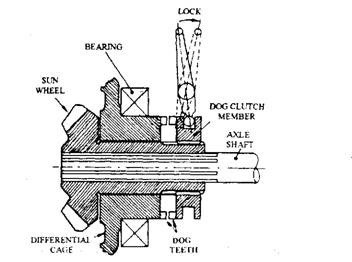Differential Lock

Differential Lock In a two-wheel drive vehicle if one driving wheel loses adhesion, the propelling force is considerably reduced. This results in the immobilization of the vehicle so that the differential action becomes undesirable on the vehicles designed to operate over poor surfaces. This action can be prevented by locking together any two individual units of a differential. One such arrangement is illustrated in Fig. 26.45. A sliding dog clutch member is splined to a differential sun wheel, which engages with dog teeth formed on the cage of the differential. The clutch is engaged by means of a fork, which can be moved by a lever fitted on the outside of the axle. When engaged, the sun wheel, and hence the rear wheel connected to this sun gear, is made to turn at the same speed as the cage. Locking one sun gear to the cage in this way ensures that the other sun gear also turns at the same speed. Fig. 26.45. Differential lock
